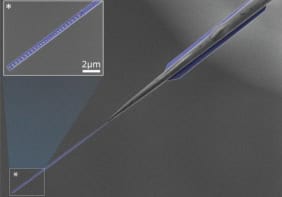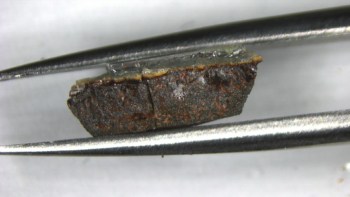Evidence is mounting for the existence of a strange new state of matter called a "supersolid", in which a small fraction of ultracold helium decouples from the rest of the solid and flows effortlessly through the material as if it were not there. Although the first clear signs of supersolidity were obtained three years ago by Moses Chan and colleagues at Pennsylvania State University in the US, subsequent research cast doubt on those findings. Now, however, Chan has measured the specific heat of several helium-4 samples and has found a peak in the data that he says is a "probable" signature of the supersolid phase (Nature 449 1025).

Supersolidity was first predicted in 1969 by Russian theorists Alexander Andreev and Ilya Liftshitz. They said that lattice vacancies in solid helium could all collapse into the same quantum state if the helium were cooled to an extremely cold temperature. This Bose-Einstein condensate (BEC) of vacancies would behave as a coherent entity, moving throughout the rest of the solid like a superfluid.
In 2004 Chan and his graduate student Eun-Seong Kim found the first evidence for superfluidity in a torsional oscillator, which consisted of a cylindrical cell filled with high-pressure helium-4. The cell, which was suspended from a rod, was rotated back and forth while being cooled. When the temperature reached about 200 mK, the researchers saw a sudden change in the oscillation period of the cell, which they interpreted as evidence that about 1% of the helium had “decoupled” from the solid helium-4 and was not oscillating.
Although this was taken as a sign of supersolidity, subsequent experiments by Chan and others revealed that the decoupling temperature and the percentage decoupled varied significantly from sample to sample. This led some physicists to suggest that the observed effect was not caused by condensing vacancies, but rather by either the flow of superfluid helium along grain boundaries in polycrystalline samples, or by a transition to a “superglass” phase. Earlier this year Chan and colleagues repeated their torsion experiments on a single-crystal of helium-4 – which had no grain boundaries. This time the decoupling occurred at the lower temperature of 75 mK with only 0.3% of the sample decoupling – the strongest evidence yet that the vacancies became a superfluid.
Now Chan and colleagues have measured the specific heat – the energy required to change the temperature of a material – of several helium-4 samples. They found peaks in the specific heat at about 75 mK, which they concluded to be a “probable” signature of the supersolid phase. “If there is a real phase transition from the normal solid to the supersolid phase, there should be a thermodynamic signature, like a peak in the specific heat of solid helium”, explained Chan. However, the experiment was not designed to measure the simultaneous decoupling of mass, and therefore the team cannot be certain that the peak is associated with supersolidity.
The team also found that the temperature dependence of the specific heat was at odds with that expected if a glassy state was forming in the solid – ruling out the superglass explanation for decoupling.
The peak in the heat capacity suggests that the supersolid state emerges in a second-order or continuous phase transition – just like superfluidity. “There is no theoretical consensus on the nature of the supersolid phase”, said Chan, “[but] based on our knowledge of superfluids, the transition is more likely to be second order, than say first order”.
Chan told physicsworld.com that the team have incorporated new and more sensitive thermometers into their apparatus, which should allow them to get a better idea of the exact shape of the peak. By analyzing the shape, the team could get a better understanding of the nature of the phase transition. Chan is also keen to look for other signatures of supersolidity such as “second sound”, which is a dramatic increase in the thermal conductivity of a material when it becomes a superfluid.



